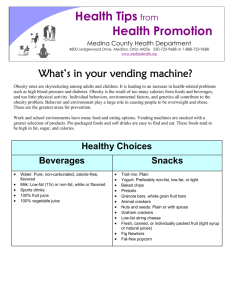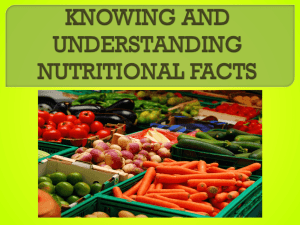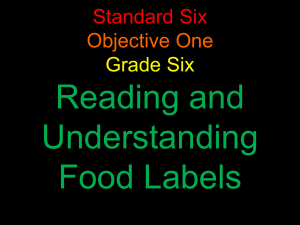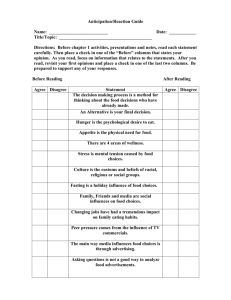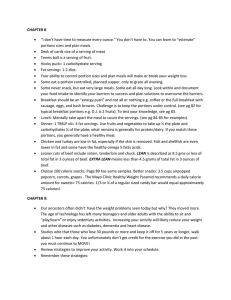Nutrition Labels
advertisement
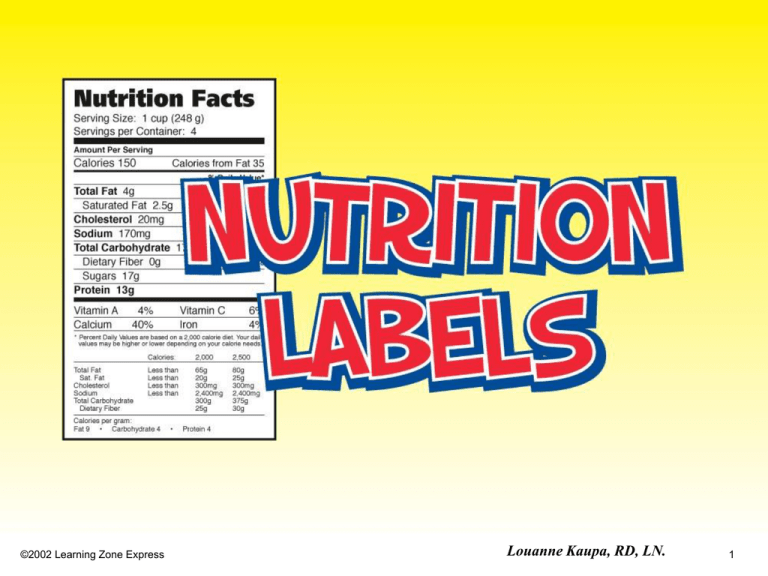
©2002 Learning Zone Express Louanne Kaupa, RD, LN. 1 Introduction As a consumer you can learn a lot from the nutritional labels placed on food items. Labels help a consumer learn more about the ingredients in a product, the nutritional value, and how to fit the food into a healthy diet. ©2002 Learning Zone Express 2 Introduction In this presentation you will learn how to: • Recognize the important facts on food labels. • Define nutrition terms used on labels. • Compare food products. • Select foods based on nutritional value. ©2002 Learning Zone Express 3 History of Food Labels Food labels were first developed when nutrient deficiencies were common. In 1993, nutrition information on the label changed to reflect the increasing public health concern over dietary excesses. ©2002 Learning Zone Express 4 History of Food Labels Food labels of the past were often confusing to consumers due to: • Listing of nutrients in metric weights. • Portion sizes being listed in metric weights. • Complicated fine print. • Information about dietary fats, fiber and sugar not included and/or misleading content. ©2002 Learning Zone Express 5 Rules and Regulations Today’s food label rules and regulations are developed by: • The Food and Drug Administration (FDA) • The Food Safety and Inspection Service of the United States Department of Agriculture. • Tens of thousands of public comments have been used in helping write the food label rules. • Anyone can petition for a change in rules but the final decision is left up to legislation. ©2002 Learning Zone Express 6 Current Food Label Requirements Food labels are standardized to make them easy for the consumer to understand and to make food comparison easier. ©2002 Learning Zone Express 7 Current Food Label Requirements The current requirements include: • Nutrition information that is shown a universal form. ©2002 Learning Zone Express • Any health claim must be supported by scientific evidence and approved by the Food and Drug Administration (FDA). 8 Current Food Label Requirements • Serving sizes are standard or represent a usual serving. • Percent of Daily Values reflect how one serving of the food fits into a 2000 calorie per day reference diet. ©2002 Learning Zone Express 9 Current Food Label Requirements • The ingredient list names the ingredients in order by the most weight to the least amount of weight. • An address or phone number of the manufacturer/distributor must be on the label. ©2002 Learning Zone Express 10 Exceptions to the Rules Some foods or food products are not required to have a “Nutrition Facts” label. ©2002 Learning Zone Express 11 Exceptions to the Rules Some of the current exceptions include: • Plain coffee and tea. • Spices, flavorings, and foods with no significant source of any nutrient. • Foods that are packaged in “sample” sizes not reflecting a “usual” serving. • Ready-to-eat foods prepared on site. • Fruits, vegetables, and fish. ©2002 Learning Zone Express 12 The ‘Nutrition Facts’ Serving size of the food in both a household measuring unit and its metric equivalent. The total Calories in each serving and the total calories from fat. The number of servings in the container. Nutrition information is listed as amount of “% Daily Value” it represents per serving. Nutrition information that must be listed on the “Nutrition Facts” panel includes: ©2002 Learning Zone Express 13 The Percent Daily Values “% Daily Values” are used to show (1) serving of food fits into a 2000 calorie reference diet. ©2002 Learning Zone Express 14 The nutrition information that must be listed on the “Nutrition Facts panel include: • Total fat • Saturated fat • Cholesterol • Sodium • Total Carbohydrate • Dietary Fiber • Sugar • Protein • Vitamin A • Vitamin C • Calcium • Iron ©2002 Learning Zone Express 15 Terms Used On Food Labels Diet - A food that is either a low calorie or reduced calorie food. Low Calorie - Contains no more than 40 calories per serving. Reduced Calorie - Contains 25 percent fewer calories per serving than a “regular” product. Fat Free – ½ g or less of fat per serving. ©2002 Learning Zone Express 16 Terms Used On Food Labels Low Fat - 3 g or less of fat per serving. Calorie-Free - Contains less than 5 Calories per serving. Sugar-Free - Contains less than half a gram of sugar per serving. ©2002 Learning Zone Express 17 Terms Used On Food Labels Excellent Source - Provides at least 20% of the Daily Value per serving. Good Source - Provides 10-19% of the Daily Value per serving. Healthy - Allowed only on food items which are low in fat, saturated fats, cholesterol, and sodium. Is usually used with an approved health claim and then only as “part of a healthy diet”. ©2002 Learning Zone Express 18 Light • A serving provides 1/3 fewer calories or half the fat of a “regular” product. • A serving of a low calorie, low fat food provides half the sodium normally present. ©2002 Learning Zone Express • The product is light in color or texture and the label describes this. 19 Terms Used On Food Labels Reduced - Contains 25% less of a nutrient or calories than a “regular” product. Low Sodium - 140 mg. or less of sodium per serving. Very Low Sodium - 35 mg. or less sodium per serving. Lean - Not more than: 10 g Fat, 4.5 g Saturated fat, and 95 mg. cholesterol or less per serving. ©2002 Learning Zone Express Extra Lean - Not more than: 5 g of fat, 2 g Saturated fat, or 95 mg. cholesterol per serving. 20 Health Claims In the past, many labels listed false claims to improve health or prevent certain diseases. Today, the FDA has very strict guidelines on which nutrients may be linked with diseases. The guidelines were created based on scientific evidence. The following are health claims which currently have been proven and can be listed on FDA approved food products. ©2002 Learning Zone Express 21 Health Claims Calcium linked to Osteoporosis. Product must be high in calcium. Sodium linked with high blood pressure. Foods must be low in sodium. Dietary fat linked with certain cancers. Foods must be low fat. Dietary saturated fat and cholesterol linked with coronary heat disease. Foods must be low in saturated fat, total fat, and cholesterol. Fiber linked to certain cancers. Foods must be low fat and a good source of natural dietary fiber. Fruits and vegetables linked with certain cancers. Foods must be low fat and an excellent source of natural fiber, vitamin A and vitamin C. ©2002 Learning Zone Express 22 Comparison Claims Today many products use the terms “reduced”, “fewer”, “less”, “more”, and “light” to assist in comparison shopping. In order to use these terms the manufacturer must include the percent difference with the product being compared. Products using the terms “light” or “reduced” must be compared with a similar product. Products using the terms “less” or “fewer” may be compared to different products. For example, chips may be compared to pretzels. Products using the terms “enriched”, “added”, or “fortified” must have 10% or more of the Daily Value for a particular nutrient than the product being compared. ©2002 Learning Zone Express 23 Main Dishes Many consumers today are purchasing entire meal entrees. Consumers want to know how these meals fit into the daily nutritional values. The FDA defines a “main dish” as weighing at least 10 ounces and with at least 3 different foods from at least 2 of the 4 main food groups. Food label claims on “main dishes” are subject to the same rules and regulations as individual foods. The food label should also list the total nutrients in an entire packaged item that’s meant for a single use. ©2002 Learning Zone Express 24 Dietary Guidelines for Americans The Dietary Guidelines for Americans were developed by the USDA and US Department of Health and Human Services. ©2002 Learning Zone Express 25 Dietary Guidelines for Americans Aim for fitness Aim for a healthy weight. Be physically active each day. ©2002 Learning Zone Express A 26 Dietary Guidelines for Americans Build a healthy base Let the Pyramid guide your food choices. Eat a variety of grains daily, especially whole grains. Eat a variety of fruits and vegetables daily. Keep foods safe to eat. ©2002 Learning Zone Express B 27 Dietary Guidelines for Americans Choose sensibly Choose a diet that is low in saturated fat and cholesterol and moderate in total fat. Choose beverages and foods to moderate your intake of sugars. Choose and prepare foods with less salt. If you drink alcoholic beverages, do so in moderation. ©2002 Learning Zone Express C 28 You’re the Expert You are grocery shopping with your Grandma who tells you she never reads food labels because of her bad experiences with them in the past. Explain to her how the food labels have changed and the information they provide. Discuss your responses in small groups and then create a role play to present to your class on what your group would do in this situation. ©2002 Learning Zone Express 29 Applying What You Know Pick one of the following assignments to be completed outside of class. Select three different food labels and display them on a poster. Include descriptions of each part of the label. Also write a brief description of how you would include this product in your daily diet. Visit a local supermarket and do your own comparison shopping. Select five different foods to compare to at least three similar items. (For example, compare three different types of frozen pizzas, or three different brands of cereal) Which product would you select in each of the five categories and why? Write a one-page summary of your results. Design your own label for a product of your choice. Be sure to include accurate information and meet all of the food label requirements. Present your label to the class and share the product information. ©2002 Learning Zone Express 30 Quiz Choose the best answer for the following questions. 1. Food label regulations are developed by the: a) FDA b) Food Safety and Inspection Service c) United Supermarket Association d) A and B 2. Which of the following is not a current requirement on food labels? a) Information is current and accurate. b) Health claims are scientifically proven. c) The product is compared with a similar product. d) A phone number or address of the distributor /manufacturer is on the label. 3. Which of the following terms refers to a product which has .5 gm or less of fat per serving? a) Low Fat b) Light c) Reduced Fat d) Fat Free ©2002 Learning Zone Express 31 Quiz 4. Which of the following items must be included on a food label? a) Nutrition Facts b) Total number of servings c)Total Calories from fat d) All of the Above 5. Which comparison terms can only be used when comparing similar product items? a) “less” or “fewer” b) “Healthy” c) “light” or “reduced” d) “more” ©2002 Learning Zone Express 32 Exploring the Web Here are some suggested sites you and your class may want to investigate for more information on nutrients. • http://vm.cfsan.fda.gov/label.html – FDA Food Labeling Web Site • http://www.kidshealth.org/parent/nutrition_fit/nutrition/food_labels.html – Facts and information on understanding food labels • http://www.sugar.org/health/labeliq.html – Test your food label IQ Teachers: Please note that these addresses are constantly changing and being updated. You may need to revise this list. ©2002 Learning Zone Express 33

